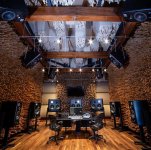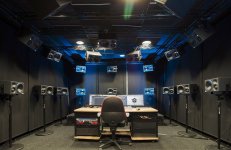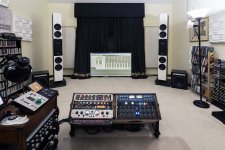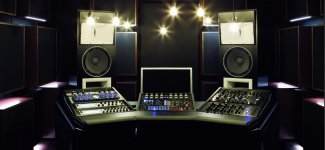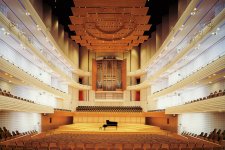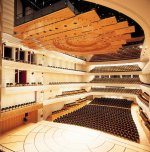Technically two subs are multi, so yeah I guess you're right. But that really wasn't my point. The assumption that the average listener has better listening conditions than a professionally designed studio is just absurd. Even with the admittedly significant problems the working conditions in studios dictate.
It is of course possible to build a recreational music room that sounds really really good without the studio-inherent problems and I'm sure some here did that, but it takes a little more than a receiver with some auto-measurements to get there.
It is of course possible to build a recreational music room that sounds really really good without the studio-inherent problems and I'm sure some here did that, but it takes a little more than a receiver with some auto-measurements to get there.
Studios are set up to listen at high DB. Subjectively, I find the higher the DB, the more issues with the room. At regular listening levels, I'd put my system up against most studios. Mind you, I do have floating CLD walls.
It seems to be the latter as you say you dont like reality.
That's cheap.
Well if you have a solution for putting a desk with several screens, keyboard, controllers, gear etc in-between the person and the speakers in a way they do not negatively impact the sound, please let me know. In mastering rooms it is indeed done sometimes, but that's a specialty scenario.
I was talking about your comment about LFs in rooms as being an unsolvable problem.
Mind you, I do have floating CLD walls.
Wow, I thought that only I did that! Good to hear.
"Reality" as in live sound at a venue can sound crappy, as we all know. So I would agree - live performance does NOT mean good sound. I think all would agree on that.
Also it would be fair to say that "often", live amplified performance is not good sounding. The music is too loud or the venue is too loud.
So in turn, if someone prefers studio recordings to live music I don't think we can draw any meaningful conclusions from that preference.
Also it would be fair to say that "often", live amplified performance is not good sounding. The music is too loud or the venue is too loud.
So in turn, if someone prefers studio recordings to live music I don't think we can draw any meaningful conclusions from that preference.
Last edited:
I would not agree to "big role."
the vast majority of preferred metrics are common among all listeners. Only as one has resolved known issues like frequency response, directivity control, etc. will the differences in perception bias (like level of DI, or flatness of DI,) enter into the equation. All agree that a smooth DI and a smooth FR are essential and not until other things have been brought under control will these factors even become significant.
But you make exactly my point, the details come down to musical preference not transducer sound quality and rooms
I'm glad you said it....lol
any other views are
That's cheap.
And antiquated
and basically perpetuating the circle of confusion and people with these views need to be ostracized from the group responsible for engineering sound reproduction until they're views have come up to date.....
So this part
It's hard enough to get a decent sounding pair of speakers into a room... changing the entire room to sound better... tough sell.
Where I was going with the addressing the room; Active room treatment? More developments of cardioid techniques maybe?
I am going out on a stretch and saying that likely, todays systems can recreate this experience?...If it does not exist narrowly with the sweet spot of a superbly accurate 2 way system ...may be within something like pictured below?This is my problem - todays systems cannot recreate reality i.e. a music event in a hall.
Attachments
Last edited:
if someone prefers studio recordings to live music
Just to be clear, my reference was more to live concert hall (classical) music rather than live amplified music. There is much more to screw up with amplified music - sound quality wise - and it is all too common. But I have seen some awesome live amplified performances, it's just that they are so rare anymore that I just don't go.
Yes, I of course understand this. But I'm sure with modern tech there are less obtrusive solutions. There are studios that do it. I see the massive analog console as almost a mark of status, like doctors wearing the stethoscope even if it could just as well sit in their office along with their other instruments.
Mindsource - I think you'll find that the desk are already trying to facilitate your view....its hard enough to convince people to start engineer ITB as they believe analog hardware has a certain magic to it...in certain cases they are correct...but the shapes of desk are meant to help be not acoustically seen...that doesn't stop one from setting up the rest of the room improperly...and there are plenty of people now (I think) who are going for the improvement had once everything is moved out of the the way
I don't know what the hold up is....I imagine a chair and a laptop....in my lap
Also remember its mainly the mastering studios aiming for the highest SQ. Not just any type of studio or control room.
Attachments
Last edited:
@Camplo
By “antiquated” I meant ‘concert hall recreation’ being more akin to LARPing than it is to the goals of modern audio fidelity. Musique concrète and primitive electronic instruments before it were already signaling an aesthetic shift away from archiving the sound of concert halls and towards the McLuhanist notion of the medium being the message itself (ie studio work). Recreating a concert hall experience is still a worthy goal if that is what gives one enjoyment but as a summation of the goals of audio fidelity it is, like I said, a bit antiquated.
By “antiquated” I meant ‘concert hall recreation’ being more akin to LARPing than it is to the goals of modern audio fidelity. Musique concrète and primitive electronic instruments before it were already signaling an aesthetic shift away from archiving the sound of concert halls and towards the McLuhanist notion of the medium being the message itself (ie studio work). Recreating a concert hall experience is still a worthy goal if that is what gives one enjoyment but as a summation of the goals of audio fidelity it is, like I said, a bit antiquated.
That's cheap.
May so be but you have to admit it was a straight logical conclusion from of one of your previous statement. No?
//
Mind you, I do have floating CLD walls.
Just like the average listener! ;-) But I'm sure that makes for a really good room, congrats.
But yes, back to waveguide designs (and their implementation if I may). Does anybody know what Meyersound does in their Bluehorns to get that kind of phase response? Otherwise it looks like a pretty ordinary speaker with even more outrageous pricing than the Strauss. But I like the basic design specs. Large 80x50 waveguide on top of a 12-inch woofer. In some way it actually reminds me of Mabat's Tritonia (the whole speaker he proposed a while back), just slightly more asymmetric and of course with basically no consideration of diffraction issues.
I like the 12-inch as that allows one to either go three way or multisub. They apparently got a patent for their digital phase correction. Any idea what they're doing there? If it's FIR based it can't have many taps for the intended applications due to latency restrictions.
It seems to me a design like this actually can be done better with a good Ath4-based waveguide for a fraction of the money. But the phase response is impressive.
Read Newall & Holland' High Performnce Loudspeakers about (their!) in-wall mounted dedicated Studio Monitors (as opposed to the average Monkey Coffins for the deaf).
The horn:

The flush-mounted monitors:

The paper:
Attachments
Ok - I see what you mean and I do agree within the realm of what is seen as SOTA today. But to me, there is a very long way to go to a completely thrilling reproduction of Mahler 4th as experienced in a concert hall. This is my reference and my goal. For that to happen, a capture-reproduction architecture is in need to be defined that can achieve the above. Whit that in mind I wrote "big role" as not many go regularly to experience natural non-amplified instruments so "good sound" is an opinion what sounds "nice" rather than correct.
//
"SOTA"?
But you make exactly my point, the details come down to musical preference not transducer sound quality and rooms. I have been to many live concerts and they don't thrill me like a good studio recording and film. I, personally, find them kind of dull. Hence we have a personal preference bias along certain directions based on our musical tastes.
This is what the designer of the expensive "SOTA" studio monitors - with the terrible horn, has to say:
"...The audience at home and in the cinema quickly got used to the transparency offered and increasingly went, with the same expectation of tonal richness and detail, to the concert halls - and was disappointed. Because especially the famous shoe box concert halls (Haydn Hall Eisenstadt, Musikvereinssaal Wien, Concertgebouw Amsterdam, Boston Symphony Hall, Tonhalle Zurich etc.) didn't provide this transparency, these were optimized for Haydn's symphonic music, a complex interplay of forward orientation (localization through direct sound) and room impression (listener wrapping through reflections) by means of cuboid structures (long, narrow, high) made of stone (little resonating wood!), In which barely absorbent materials were used and sound reflections remain in the audience for a long time.
How could architects and acoustic designers meet the new requirements for transparency? Already in the in the 1940s, concert halls were realized that had a funnel-shaped floor plan and were also equipped with absorbent materials (fabrics, upholstery, carpets). In the neck of the funnel the orchestra was seated and in the mouth of the funnel the listeners sat, so that the side sound reflections were quickly diverted to the back of the room.
As a result, as in hi-fi reproduction, the direct sound from the instruments began to dominate, and it showed a transparent sound image, however without hall/room sound, something that is essential for an impressive performance of symphonic music. The so-called hi-fi concert halls were therefore in need of revision, albeit the acoustic performance of chamber music and electro-acoustic music was considered good."
Last edited:
"Since no physically fixed concert hall can meet all the needs of musical acoustics, all that remains is the concept of a certain room acoustic variability. The following sound aesthetic aspects are to be combined, though the historical requirements should be taken into account: rest/silence/tranquility (purity), spatial impression (envelope), transparency (clarity and detail).
This procedure was exemplified in the Salle Blanche of the KKL Luzern: works of electroacoustic music, chamber music, symphony and sacred music can be performed here - variable absorption (fabrics), variable reflection (canopy over the stage) and a variable room volume (echo chambers) make it possible. For a structure of this size and considering the location (city center) the silence in the hall allows for undisturbed recordings of music from the piano-pianissimo area - such characteristics were, until now, only found in the best music studios.
The maximum acoustic variability available today facilitate the electroacoustic production and reproduction processes of surround sound, ambisonic and wave field synthesis. With these methods, all types of rooms - including those which cannot be physically implemented, can be constructed or mimicked acoustically.
However, the reproduction or production of these sound spaces continues to be bound to conditions that describe an acoustic non-location: free field, anechoic room or headphones. Music can be heard everywhere that has not been performed anywhere."
This procedure was exemplified in the Salle Blanche of the KKL Luzern: works of electroacoustic music, chamber music, symphony and sacred music can be performed here - variable absorption (fabrics), variable reflection (canopy over the stage) and a variable room volume (echo chambers) make it possible. For a structure of this size and considering the location (city center) the silence in the hall allows for undisturbed recordings of music from the piano-pianissimo area - such characteristics were, until now, only found in the best music studios.
The maximum acoustic variability available today facilitate the electroacoustic production and reproduction processes of surround sound, ambisonic and wave field synthesis. With these methods, all types of rooms - including those which cannot be physically implemented, can be constructed or mimicked acoustically.
However, the reproduction or production of these sound spaces continues to be bound to conditions that describe an acoustic non-location: free field, anechoic room or headphones. Music can be heard everywhere that has not been performed anywhere."
Last edited:
Not sure what the Salle Blanche is, if it's the same thing as I'm not aware of such a room, but the main concert hall at the KKL Luzern is indeed stunning.
- Home
- Loudspeakers
- Multi-Way
- Acoustic Horn Design – The Easy Way (Ath4)

